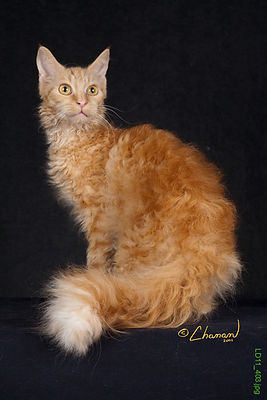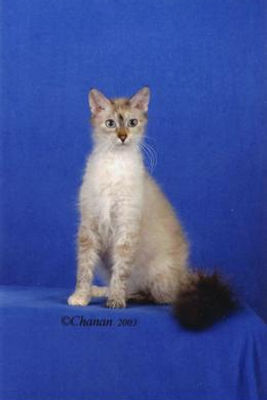
Where It All Began
From the Beginning…
By Dennis Ganoe (Dennigan LaPerms)
Dennis judging at a cat show
I was familiar with the recognized Rex breeds and these looked nothing like the Devon or Cornish Rex. (The Selkirk Rex was not yet accepted). They did not look like the American Wirehair either. They were moderate in size with svelte bodies. They had distinctive muzzles with pronounced whisker pads. They all seemed to have a distinctive “look” that told me they were obviously related in some manner. There were long hair varieties and short hair varieties. She had red tabby, brown tabby, some with white and a pointed cat as well. All were of the same distinctive style and all with curly hair.
Although I was dedicated to the Cat Fanciers Association, I advised Linda to first seek recognition from The International Cat Association. TICA is a genetic registry and if she could get their geneticists to certify this as a new mutation they would recognize her cats as a new breed relatively quickly. Once recognized as a new breed, they could be registered with TICA and shown in their New Breeds and Colors category. There are many people who enjoy showing only new breeds and she would find herself with more volunteers to help promote the breed. This would pave the way to get recognition in other associations.
Linda contacted Solveig Pfluger, the leading geneticist with TICA and Solveig requested hair samples and even took a couple of cats into her home to study them and determine their genetics. She was able to determine that this was indeed a different mutation, even from the newly recognized Selkirk Rex. More than that, Solveig determined this was a simple dominant gene and that it affected all four types of hair equally (guard, down, awn and whisker). Further, this mutation does not cause the whiskers to be brittle, but leaves them supple. This has become a differentiation between the LaPerm and other Rex breeds. The LaPerm is the only one with flexible whiskers that curl.
After recognition by TICA, Linda began to take her cats to local TICA shows where they competed in the New Breeds and Colors (NBC) category. She did enlist others to help with showing LaPerms. At a large TICA media heavy show in Los Angles, Linda and her LaPerms were featured on the local television station promoting the show. Linda’s father lived in the Los Angeles area and helped with her at this show. Linda’s father, who was retired, was quite encouraging of this new breed. He died not too long after this show but bequeathed to Linda funds specifically earmarked towards earning recognition of her new breed. This proved to be quite beneficial as it was very expensive to travel around with multiple cats to various cat shows promoting a new breed.
While Linda was getting the breed recognized in TICA, the people she enlisted to help were using their contacts to get the breed spread around the world. It was through these people that LaPerms were sent to Australia, England, Europe and South Africa. Although it was human activity that sent the breed to the world, it has been the cats themselves that have won the hearts of cat fanciers around the world.
During the drive to get the breed recognized in TICA and the rest of the world, I continued to offer advice when I could but I was limiting myself to CFA. I had long told Linda that when registration was allowed in CFA, I would start a breeding program and help promote the breed in CFA. It was 8 years between that first CFA show where the breed was first exhibited and acceptance for registration by CFA. Months after CFA started registering LaPerms, I got my first LaPerm from Linda and began breeding LaPerms under the cattery name Dennigan. While I was waiting for CFA registration, the breed had spread around the world and gathered many dedicated fanciers for many registries.
I am pleased that my enthusiasm helped Linda decide to seek recognition as a new breed for her barn cats. It has been a long road and the journey is not yet complete. We have championship status in most associations and the dedicated breeders in Europe have held their first FiFE recognition show. This is the first step leading to full recognition by FiFE affiliated clubs in Europe. This will be the last major association of cat fanciers in the world to accept the breed and everyone is hopeful it will be done quickly.
I subsequently spoke with Linda. Although she had retired from breeding and showing, she is very proud of her barn cats. She is very thankful for all the support her hobby project has received throughout the world. From a small cherry orchard in The Dalles Oregon to the biggest stages in the cat fancy, the LaPerm has grown to have a dedicated following.
Since Linda’s death, her daughter Sandy Wilson has taken a few cats and will continue the Kloshe line of LaPerms.



In 1992, I had only been involved with pedigreed cats for a few years. I was working as the Master Clerk for a CFA show in Portland, Oregon. For those not familiar with how shows are conducted in CFA, there are multiple judges judging simultaneously. Each judge will see every cat in the show, so essentially there are multiple shows going on at once. Each judge has a clerk who records how they place the cats in their ring and the Master Clerk is the person who compiles all the results from all the judges into a master record submitted to the association as a record of the show. That was my job at this show. It meant that I knew what was going on in the show hall most of the time.
On Saturday (of a two day show), I noticed there were a set of empty cages in the benching area. This was unusual because I knew who was present and who was absent and these empty cages were not what I expected. Apparently, these cages were for ‘exhibition only’ meaning the cats that were supposed to be in them were not entered into competition. When Sunday rolled around, I noticed that these cages were no longer empty. Someone I did not know was present and putting cats into the benching area for display. The cats were unusual in that they had curly fur.
I was intrigued. I asked her name and where she got these unusual cats. She told me her name was Linda Koehl from The Dalles and that the cats were some of her barn cats. She was pleasantly surprised that they were taking to the cages so well since she said they have never been off the farm before and were not caged at home. They lived in her barn and kept the rodent population in check in her cherry orchard.
To say I was excited was an understatement. Since I was involved in running the show, I was able to go to the microphone and announce that we had a new breed of cat present in their first ever showing. I invited everyone to go over the benching area and see these cats. At my urging many people came over to look at the cats. This included some Cornish Rex breeders, Devon Rex breeders and an American Wirehair breeder. They all came by to look, touch and examine these new cats. We all agreed these were like nothing else we’d seen in the cat fancy. We had ourselves a new breed!
At this time, they didn’t have a breed name. I found out from Linda that she had had her first curly haired kitten born in 1982 and that she had been keeping track of the curly hair kittens off and on for 10 years. Her husband had told her a couple of weeks prior that she needed to ‘do something with them or get rid of them’. That’s when she saw an advertisement in the newspaper about an upcoming ‘cat show’. She knew neither nothing about cat shows nor that the Cat Fancy even existed. She contacted the number in the ad and arranged to ‘exhibit’ her unusual cats at the show. She couldn’t get Saturday off from work so she planned on bringing some cats only on Sunday.
Linda was unprepared for the buzz her cats generated. I have to admit, I was the chief cheerleader because I recognized this was the birth of a new breed. Linda had yet to decide on a breed name so she didn’t know what to call them when people asked. That was something she did several months later. She was still learning that people actually kept cats as pets, not simply as farm animals and had no idea people would ‘compete’ one cat against another in competition. It was an eye opening experience for everyone.
Linda and I spoke quite a lot during the day and I made sure Linda had my contact information because I wanted to keep in contact with her and her new breed. We continued to speak after the show, off and on, because Linda was so impressed by the reaction her cats got that she wanted to continue exhibiting them. She asked me many questions about how to get her cats recognized. She wanted to know how to manage a breeding program and we discussed that at great length. I found out that Linda had been keeping pictures of the cats on her farm and recording which cat had which litter. She had decided that she couldn’t keep all the kittens and had been finding them homes with friends, neighbors and relatives. She kept the ones that she liked and found homes for the others. I let her know that what she was doing was basically what a breeding program did. She was recording the litters, keeping the ones she liked and finding homes for the others. She did not know what a breed standard was and did not know how to prepare her cats to be shown. I helped her understand what a written breed standard was and her first attempts at writing down what she liked helped solidify what she wanted this breed to look like.
Double Grand Champion Dennigan BC French Maid, first USA champion
Kloshe BC Phoenix of Dennigan